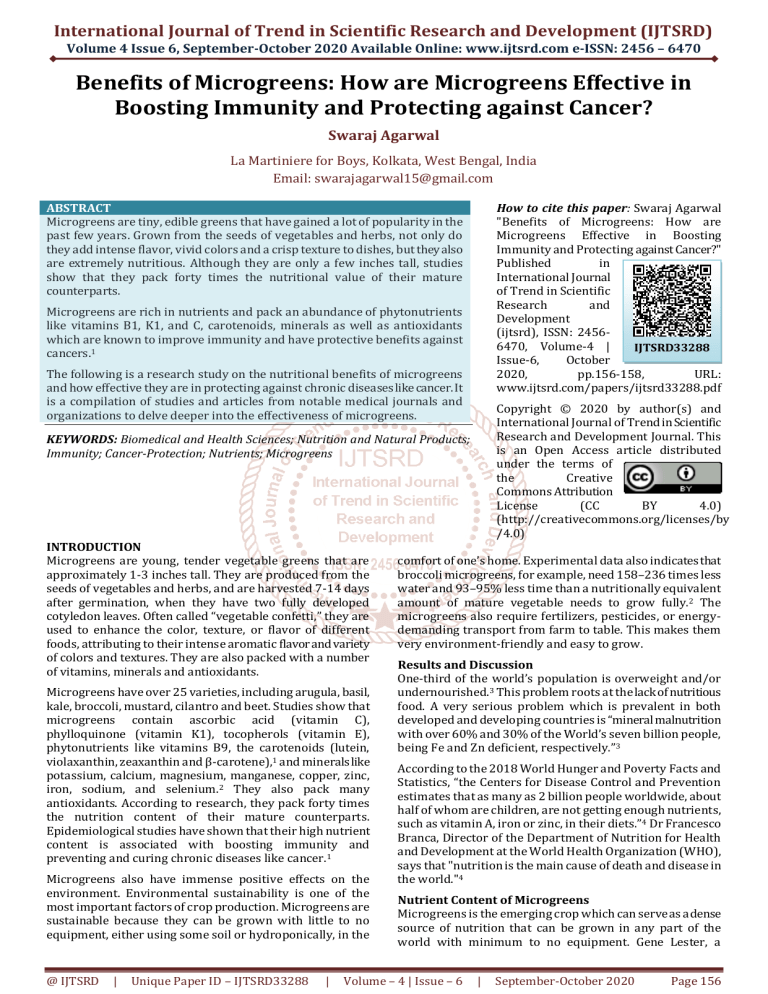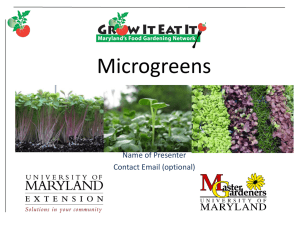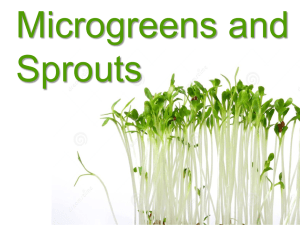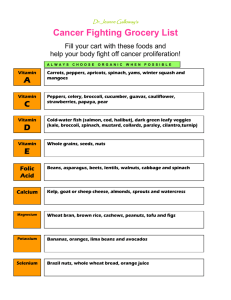
International Journal of Trend in Scientific Research and Development (IJTSRD)
Volume 4 Issue 6, September-October 2020 Available Online: www.ijtsrd.com e-ISSN: 2456 – 6470
Benefits of Microgreens: How are Microgreens Effective in
Boosting Immunity and Protecting against Cancer?
Swaraj Agarwal
La Martiniere for Boys, Kolkata, West Bengal, India
Email: swarajagarwal15@gmail.com
ABSTRACT
Microgreens are tiny, edible greens that have gained a lot of popularity in the
past few years. Grown from the seeds of vegetables and herbs, not only do
they add intense flavor, vivid colors and a crisp texture to dishes, but they also
are extremely nutritious. Although they are only a few inches tall, studies
show that they pack forty times the nutritional value of their mature
counterparts.
How to cite this paper: Swaraj Agarwal
"Benefits of Microgreens: How are
Microgreens Effective in Boosting
Immunity and Protecting against Cancer?"
Published
in
International Journal
of Trend in Scientific
Research
and
Development
(ijtsrd), ISSN: 24566470, Volume-4 |
IJTSRD33288
Issue-6,
October
2020,
pp.156-158,
URL:
www.ijtsrd.com/papers/ijtsrd33288.pdf
Microgreens are rich in nutrients and pack an abundance of phytonutrients
like vitamins B1, K1, and C, carotenoids, minerals as well as antioxidants
which are known to improve immunity and have protective benefits against
cancers.1
The following is a research study on the nutritional benefits of microgreens
and how effective they are in protecting against chronic diseases like cancer. It
is a compilation of studies and articles from notable medical journals and
organizations to delve deeper into the effectiveness of microgreens.
Copyright © 2020 by author(s) and
International Journal of Trend in Scientific
Research and Development Journal. This
is an Open Access article distributed
under the terms of
the
Creative
Commons Attribution
License
(CC
BY
4.0)
(http://creativecommons.org/licenses/by
/4.0)
KEYWORDS: Biomedical and Health Sciences; Nutrition and Natural Products;
Immunity; Cancer-Protection; Nutrients; Microgreens
INTRODUCTION
Microgreens are young, tender vegetable greens that are
approximately 1-3 inches tall. They are produced from the
seeds of vegetables and herbs, and are harvested 7-14 days
after germination, when they have two fully developed
cotyledon leaves. Often called “vegetable confetti,” they are
used to enhance the color, texture, or flavor of different
foods, attributing to their intense aromatic flavor and variety
of colors and textures. They are also packed with a number
of vitamins, minerals and antioxidants.
Microgreens have over 25 varieties, including arugula, basil,
kale, broccoli, mustard, cilantro and beet. Studies show that
microgreens contain ascorbic acid (vitamin C),
phylloquinone (vitamin K1), tocopherols (vitamin E),
phytonutrients like vitamins B9, the carotenoids (lutein,
violaxanthin, zeaxanthin and β-carotene),1 and minerals like
potassium, calcium, magnesium, manganese, copper, zinc,
iron, sodium, and selenium.2 They also pack many
antioxidants. According to research, they pack forty times
the nutrition content of their mature counterparts.
Epidemiological studies have shown that their high nutrient
content is associated with boosting immunity and
preventing and curing chronic diseases like cancer.1
Microgreens also have immense positive effects on the
environment. Environmental sustainability is one of the
most important factors of crop production. Microgreens are
sustainable because they can be grown with little to no
equipment, either using some soil or hydroponically, in the
@ IJTSRD
|
Unique Paper ID – IJTSRD33288
|
comfort of one’s home. Experimental data also indicates that
broccoli microgreens, for example, need 158–236 times less
water and 93–95% less time than a nutritionally equivalent
amount of mature vegetable needs to grow fully. 2 The
microgreens also require fertilizers, pesticides, or energydemanding transport from farm to table. This makes them
very environment-friendly and easy to grow.
Results and Discussion
One-third of the world’s population is overweight and/or
undernourished.3 This problem roots at the lack of nutritious
food. A very serious problem which is prevalent in both
developed and developing countries is “mineral malnutrition
with over 60% and 30% of the World’s seven billion people,
being Fe and Zn deficient, respectively.”3
According to the 2018 World Hunger and Poverty Facts and
Statistics, “the Centers for Disease Control and Prevention
estimates that as many as 2 billion people worldwide, about
half of whom are children, are not getting enough nutrients,
such as vitamin A, iron or zinc, in their diets.”4 Dr Francesco
Branca, Director of the Department of Nutrition for Health
and Development at the World Health Organization (WHO),
says that "nutrition is the main cause of death and disease in
the world."4
Nutrient Content of Microgreens
Microgreens is the emerging crop which can serve as a dense
source of nutrition that can be grown in any part of the
world with minimum to no equipment. Gene Lester, a
Volume – 4 | Issue – 6
|
September-October 2020
Page 156
International Journal of Trend in Scientific Research and Development (IJTSRD) @ www.ijtsrd.com eISSN: 2456-6470
researcher at the U.S. Department of Agriculture, and his
colleagues at University of Maryland, College Park,
conducted a research study to measure the nutritional
content of microgreens. The researchers analyzed the
concentration of four groups of vitamins and other
phytochemicals in 25 varieties of microgreens.
Phylloquinone, or vitamin K, was found in great quantities in
garnet amaranth (4.1 μg/g FW), green basil (3.2 μg/gFW),
and red cabbage (2.8 μg/gFW) microgreens.1 On the other
hand, according to the USDA national nutrient database,
phylloquinone concentration in mature amaranth, basil, and
red cabbage were 1.14, 0.41, and 0.04 μg/gFW, which are
much lower than the values for their corresponding
microgreens.1 Red cabbage was highest in vitamin C, while
the green daikon radish microgreens had the most vitamin E.
Other nutrients like ascorbic acid (vitamin C), carotenoids,
and tocopherols, all associated with “reduction in the
development of chronic disease, such as cancer and
cardiovascular disease”, were four to six times more
concentrated in microgreens than the mature leaves of the
same plants.1
Table 1.Mean Total Ascorbic Acid (TAA), Free Ascorbic
Acid (FAA), and Dehydroascorbic Acid (DAA)
Concentrations in 25 Commercially Grown
Microgreens1
Carolyn F Weber, in the Journal of Horticulture, has
conducted a study comparing the nutrient content of lettuce
and cabbage microgreens to that of store-bought mature
cabbage and lettuce. The findings show that the microgreens
are much more nutritious than their mature counterparts.
She found that “the average ratios across the 10 nutrients (P,
K, Ca, Mg, S, Mn, Cu, Zn, Na, and Fe) indicate that LC, LHP, CC
and CHP were 2.8, 2.7, 8.1 and 2.9 times more nutrient-rich
than the mature vegetable.2 Particularly high nutrient ratios
were observed for Fe in cabbage microgreens with CC having
54.6 times the amount of Fe as the mature vegetable, while
CHP had 5.4 times the amount of Fe as the mature
vegetable.2 For Fe, lettucemicrogreens still contained
between 2 and 3 times the amount as the mature vegetable,
but it is clear that cabbage microgreens are able to acquire
far greater amounts of Fe when grown on the same
@ IJTSRD
|
Unique Paper ID – IJTSRD33288
|
substrates. For Zn, cabbage microgreens contained between
5 and 7.5 times the amount of Zn as the mature vegetable.”2
Figure 1.Broccoli microgreen:vegetable mineral ratios
for microgreens grown on compost (C), or
hydroponically (HFG), or with water only (HW)2
Immunity Boosting and Cancer Protective Properties
Microgreens have high nutritional content and it is for this
reason that they have immunity boosting properties.
Epidemiological studies in the National Library of Medicine
have shown that consuming essential nutrients like vitamin
C, vitamin K1, provitamin A compounds, and vitamin E from
fruits and vegetables is associated with higher protection
from chronic diseases like cancer. The World Cancer
Research Fund recommends that we consume at least 600
grams of fruits and vegetables per day. Microgreens can
serve as the perfect solution – they are a dense source of
essential vitamins and minerals. They protect the body by
going to the root and building immunity in the cells so as to
prevent chronic disease.
Broccoli microgreens have known to have great cancer
protective properties – they are very often called a
superfood. According to a study conducted by Paul Talalay of
the Johns Hopkins School of Medicine, crucifer sprouts like
broccoli microgreens are able to induce 10-100 times more
carcinogen protective enzymes than larger quantities of
mature vegetables.5 Broccoli microgreens are known to be
rich in sulforaphane, which has anti-cancer effects against
prostate, breast, and urinary cancers.5 Sulforaphane is a
compound which binds to a protein inside cells increasing
the production of enzymes which resist carcinogens.
Broccoli microgreens also contain many bioactive
compounds, such as flavonoids and phenolic acids including
gallic, chlorogenic, ferulic, sinapinic, benzoic, and salicylic
acids, quercetin, kaempferol, vitamin C and glucosinolates,
which have shown anticancer activity.5
Stephanie Tortorella and colleagues also found tumor cells
with “stem cell-like self-renewal capacity that may be
responsible for relapse, metastasis, and resistance, as a
potential target of sulforaphane and may be an important
aspect of sulforaphane chemoprevention. Evidence also
suggests that sulforaphane may target the epigenetic
alterations observed in specific cancers, reversing aberrant
changes in gene transcription through mechanisms of
histone deacetylase inhibition, global demethylation, and
microRNA modulation.”6
Research also indicates that sulforaphane inhibits breast
cancer stem cells. The study conducted by Yanyan Li and
colleagues showed that sulforaphane eliminated breasts
CSCs, thereby abrogating tumor growth, and also down
regulated the Wnt/beta-catenin self-renewal pathway.7
These findings reaffirmed the use of sulforaphane for the
chemoprevention of breast cancer stem cells.
Volume – 4 | Issue – 6
|
September-October 2020
Page 157
International Journal of Trend in Scientific Research and Development (IJTSRD) @ www.ijtsrd.com eISSN: 2456-6470
John W. Finley, at the U.S. Department of Agriculture, along
with other researchers, has also conducted a study about the
cancer-protective properties of high-selenium broccoli. They
found that the Selenium from high-Se broccoli microgreens
reduces and protects against chemically induced colon
cancer in rodents, which was then transferred to
humans.8Fuente, García, Máñez, Alegría, Barberá, and Cilla at
the University of Valencia, Spain also conducted a study
about the antiproliferative effect of microgreens on human
colon cancer cells. They found that the antioxidant bioactive
compounds present in four hydroponic Brassicaceae
microgreens (broccoli, kale, mustard and radish) reduced
the proliferation of tumoral cells in the human body.9
I want to thank all those people who lay their trust on Micro
Treasures. The family of customers and well-wishers have
been a constant support to my endeavor and have made it
what it is today. This would not have been possible without
them.
Many other microgreens also have anti-cancer properties.
Chickpea microgreens contain anti-cancer compounds called
isoflavones, which have shown a remarkable inhibiting effect
on the growth of breast cancer cells. A study conducted at
Jagiellonian University has shown that the rutabaga
microgreens have a high antioxidant content and anti-cancer
properties.10 Researchers at the North Dakota State
University have found that flaxseed microgreens induce cell
death on human breast cancer cells.10
[2] Weber, C.F. “Nutrient Content of Cabbage and Lettuce
Microgreens Grown on Vermicompost and Hydroponic
Growing Pads.” Journal of Horticulture, vol. 03, no. 04,
2016, doi:10.4172/2376-0354.1000190.
All these microgreens have shown a positive effect on
inhibiting the growth of cancer cells. This is just the start.
There are many other varieties of microgreens and
continued scientific research on the benefits of microgreens
will only help in bringing their importance to the public eye.
[5] Fahey J.W.; Zhang Y.; Talalay P. Broccoli sprouts: An
exceptionally rich source of inducers of enzymes that
protect against chemical carcinogens. Proc. Natl. Acad.
Sci.
USA.
1997;
94:10367–10372.
doi:
10.1073/pnas.94.19.10367.
Conclusion
It suffices to say that microgreens are highly concentrated
sources of essential nutrients, along with being environment
friendly. They help build body immunity, which in turn is
linked with protection from diseases, including cancer.
[6] Tortorella, S.M. et al. “Dietary Sulforaphane in Cancer
Chemoprevention: The Role of Epigenetic Regulation
and HDAC Inhibition.” Antioxidants & redox signaling
vol.
22,
16
(2015):
1382-424.
doi:10.1089/ars.2014.6097.
While all this is true, it is required to mention that
microgreens have not been explored to its full potential yet.
Further research needs to be conducted to realize their
extensive benefits fully. The available research shows
promising results, but only further exploration can bring
forth all the benefits of microgreens. While eating a highly
nutritious, and nutritionally dense, plant-based diet does
stimulate the immune system, which impacts the on-set or
development of cancers and human health in general, that’s
about all there is scientifically about plant-based foods and
human cancers at this point in time. Most of the available
studies have been conducted in Vivo on cell lines. However
promising, further invitro research will be able to fully
describe the relationship between microgreens and human
cancers.
Nutritionists advise us to eat more fruits and vegetables
because observational studies consistently find an
association with less cancer. However, this also needs to be
taken into context, as people eating the most fruits and
vegetables also don’t smoke, they exercise more, aren’t
obese and maintain regular medical check-ups. Fruits and
vegetables help maintain a healthy lifestyle, and microgreens
are an easy addition in maintaining a healthy life.
Acknowledgements
I am grateful to my school, La Martiniere for Boys, Kolkata,
without which I would never be who I am today; to Mr. Rafi,
my school principal, Mr. Stephens, the vice-principal and all
my teachers, especially Mrs. Gooptu and Mrs. Chatterjee for
their constant support.
@ IJTSRD
|
Unique Paper ID – IJTSRD33288
|
Last but not the least, I would like to thank my wonderful
parents for being there beside me every step of the way. This
would never have been possible without their unwavering
faith, encouragement and support.
References
[1] Lester, G.; Xiao, Z.; Luo, Y.; Wang, Q. Microgreens:
Assessment of Nutrient Concentrations. 2013.
[3] “Global Nutrition Report.” World Health Organization,
World Health Organization, 17 Jan. 2019.
[4] “Malnutrition Is a World Health Crisis.” World Health
Organization, 15 Oct. 2019.
[7] Li, Y. “Sulforaphane, a dietary component of
broccoli/broccoli sprouts, inhibits breast cancer stem
cells.” Clinical cancer research: an official journal of the
American Association for Cancer Research vol. 16,9
(2010): 2580-90. doi:10.1158/1078-0432.CCR-092937
[8] Finley J.W., Ip C, Lisk DJ, Davis CD, Hintze KJ, Whanger
PD. Cancer-protective properties of high-selenium
broccoli. J Agric Food Chem. 2001;49(5):2679‐2683.
doi:10.1021/jf0014821
[9] Fuente, B.; López-García, G.; Máñez, V.; Alegría, A.;
Barberá, R.; Cilla, A. Antiproliferative Effect of
Bioaccessible Fractions of Four Brassicaceae
Microgreens on Human Colon Cancer Cells Linked to
Their Phytochemical Composition. Antioxidants 2020,
9, 368.
[10] Marquis, A. “Top 5 Microgreens That Kill Cancer Cells.”
Microveggy, 25 Apr. 2020.
About Author:
Swaraj Agarwal is a senior in high school at
La Martiniere for Boys, Kolkata, India. He is
passionate about the intersectionality of
sociology, economics, public health, and
environmental science, and hopes to
pursue these interests in college. He runs
Micro Treasures, a social enterprise aimed at creating
awareness about and supplying microgreens.
Volume – 4 | Issue – 6
|
September-October 2020
Page 158








